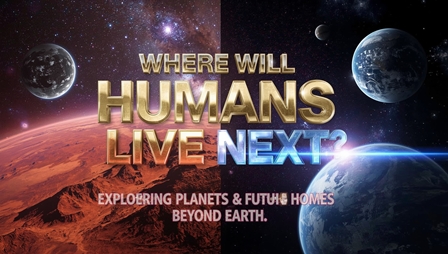Where Can Humans Live After Earth? Exploring Future Homes
Earth is our only home, but it may not last forever. Where Can Humans Live After Earth? Rising seas, climate change, and overpopulation are forcing scientists to ask: Where will humans live next?
Could we find another planet in our solar system—or even beyond—that can support life? Let’s explore the possibilities, from fiery worlds to icy moons, and see if Mars or an exoplanet could become humanity’s future home.
🔥 Mercury: The Fiery World
Mercury is the closest planet to the Sun. While it may look calm from space, living here would be impossible:
Daytime heat: 840°F (hotter than a blowtorch)
Nighttime cold: -300°F (colder than Antarctica)
Thin atmosphere with almost no oxygen
With such extremes, Mercury cannot be humanity’s backup planet.
🌋 Venus: Earth’s Deadly Twin
Venus is almost the same size as Earth and was once thought to be a tropical paradise. The reality is terrifying:
Clouds made of acid that can melt metal
Pressure 90 times stronger than Earth—enough to crush a car
Surface heat above 900°F, hot enough to melt lead
On Venus, you’d be crushed, burned, and dissolved in seconds. Definitely not an option for future humans.
🔴 Mars: Humanity’s Best Hope
Mars excites scientists more than any other planet. Why?
A day on Mars is almost the same as Earth’s
It has mountains, valleys, and signs of ancient water
Its gravity is weaker, but still manageable
⚠️ The challenges:
No magnetic shield = deadly radiation
Massive dust storms
Toxic iron dust that damages machines
👉 Despite the dangers, with protective habitats, advanced technology, and terraforming research, Mars remains the most promising candidate for human settlement.
🌪 Jupiter: The Monster Planet
Jupiter is the giant of our solar system, large enough to fit 1,300 Earths inside. But living here? Impossible.
No solid ground—only gas
Winds blowing over 250 mph
The Great Red Spot storm, larger than Earth, raging for 300 years
Intense radiation deadly to humans
Jupiter is beautiful to study but impossible to call home.
⚡ Saturn: The Storm Factory
Saturn may look peaceful with its glowing rings, but reality is different:
Winds reaching 1,000 mph
Lightning bolts bigger than any on Earth
Storms lasting for years, covering entire continents
Saturn is fascinating but far too hostile for human life.
💨 Neptune & Triton: Icy Frontiers
Neptune is a world of freezing temperatures and the fastest winds in the solar system—up to 1,200 mph. Survival here is impossible.
However, Neptune’s moon Triton offers an interesting possibility:
Surface covered in ice
Geysers shooting nitrogen into space
Potential for future human bases with special technology
Triton may one day host research stations, though colonization would be extremely difficult.
🌌 Beyond Our Solar System: Earth 2.0
Our Sun is only one of 200 billion stars in the Milky Way. Scientists are already discovering exoplanets orbiting distant stars. Some are too hot, others too cold—but a few may have the right mix of water, oxygen, and temperature to support life.
Finding “Earth 2.0” is one of humanity’s greatest missions. Until then, Earth remains the only safe home we have.
❓ FAQ Section
Q1. Why can’t humans live on Mercury?
Because its temperatures swing from burning hot to freezing cold, and its thin atmosphere has no oxygen.
Q2. Could humans survive on Venus?
No, Venus has crushing pressure, extreme heat, and acid clouds that make it deadly.
Q3. Why is Mars considered the best option?
Mars has Earth-like days, signs of water, and manageable gravity, making it the most realistic choice with technology.
Q4. Can we live on Jupiter or Saturn?
No, both are gas giants with no solid ground and violent storms that make survival impossible.
Q5. What is Earth 2.0? Where Humans Live After Earth?
Earth 2.0 refers to a distant exoplanet that may have conditions similar to Earth—potentially habitable for humans.
From Mercury’s fire to Neptune’s storms, most worlds in our solar system are deadly. Mars stands out as humanity’s best chance, though survival would require massive innovation. At the same time, the search for exoplanets continues, offering hope of an Earth-like world somewhere in the galaxy.
👉 Until then, our mission should be clear: protect Earth while preparing for the stars.




































